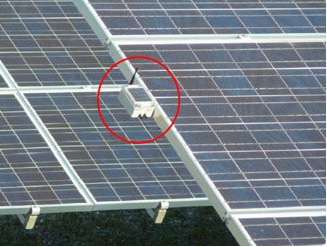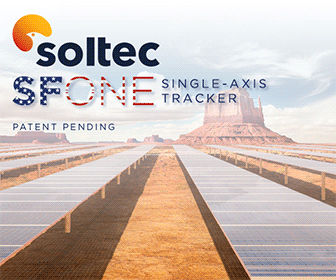Solar Panel Theft Protection
 Over the last few years, the solar industry has grown dramatically and, as with any new industry, dramatic economic gains equate to a seemingly equal number of challenges. In 2009 and 2010, photovoltaic installations exploded in the US due to federal incentives, the cash grant program, and utility sector investments—which quadrupled between 2009 and 2010.
Over the last few years, the solar industry has grown dramatically and, as with any new industry, dramatic economic gains equate to a seemingly equal number of challenges. In 2009 and 2010, photovoltaic installations exploded in the US due to federal incentives, the cash grant program, and utility sector investments—which quadrupled between 2009 and 2010.
While PV installations increased, unforeseen problems were brewing in the background. Stories of theft surfaced, shedding light on aspects of solar equipment realities overlooked by insurers, financiers, and owners. After losing 20 panels overnight, for example, a middle school superintendent reported the cost for a camera detection system would be an extra $15,000 to $17,000. Even if this school district could afford them (along with the panel replacements), would cameras alone be sufficient to prevent future solar panel theft?
In response to such risks, insurance companies rapidly updated policies initiating requirements and higher policy costs, leaving companies scrambling to find anti-theft solutions.
Tying down PVs
Security may be one of the only areas today where bipartisan support exists, making the forecast for solar promising. Even if incentives stop, and the dramatic growth in solar installations level out, existing equipment must be protected. Considering theft was virtually unforeseen when some of the initial solar power project purchases took place, today’s anti-theft measure will continue to add a hefty price tag over the next 25 to 30 years to an already expensive venture.
The lack of accurate solar panel theft information has sparked annual insurance premiums, causing them to soar. Estimates now are that they make up approximately 25% of a PV systems’ annual operating cost—depending on the system size and geographic location. In 2009, theft wasn’t covered under general liability or warranties, and many solar integrators learned the hard way when they filed a claim…only to be denied.
Comprehensive plans were desperately needed to cover losses caused by theft and natural disasters. Though homeowners are generally safe under their standard homeowner policies, they are increasingly advised to put an anti-theft solution in place. Large-scale commercial projects, in comparison, are advised to find insurance providers that cover all aspects of a solar installation—from start to finish—including the risk of theft. Some companies demand that a preventative anti-theft device be put into place during installation, while others now include theft protection in their policies and haven’t yet demanded additional equipment.
Security measures
Alarms and perimeter security are beneficial deterrents in residential, commercial, and remote solar applications. Here are some additional effective options currently being used in the field.
• Secure fencing
Secure fencing entails the use of a fiber optic cable sensor distributed along the perimeter of a fence, which is divided into zones. Once an intrusion is detected, authorities are alerted of the zone involved, along with the exact latitude and longitude coordinates. Because this is a fiber optic cable, there’s no need for electronics and software in the field. Current installations include using the cable in a remote desert application, and not only around the perimeter, but also as a wrap around individual panels for backup protection. An added benefit to secure fencing is that most application software is using the Android OS (soon expanding to the iPhone OS) for immediate tracking.
• Laser signals
Similar to secure fencing, this security option works by sending coded light signals through fiber optic cables, which are directly attached to solar panel frames via tamperproof fasteners. Any unauthorized removal triggers an alarm sent to a master station for immediate response.
• Wire detection
This security solution involves a system of wiring installed within the framework a solar system, which is designed to detect any changes. So, for instance, if a wire is cut, authorities are alerted over radio frequency, cellular, satellite, or landline networks. Generally, bright lights are then illuminated, with a piercing siren, to promote attention and cause a thief discomfort.
• Locking fasteners
A low-cost hardware solution for solar panel protection involves custom-locking fasteners. Although these fasteners do not secure the perimeter of a solar farm, or provide an alarm, they are designed to replace the standard bolts on the mounting racks, making panel removal virtually impossible. No other bit, tool, or vice grip should be able to remove them. Look for fasteners that are rust-proof, offer high torque, and are easily installed. Deep serrations underneath the head eliminate the need for nuts, lock-washers, or retightening over time. They should also provide grounding potential, and meet the security requirements needed for remote to residential solar applications.
In any of the above solutions, it’s important to look for a security system that is tamperproof, weatherproof, and relatively maintenance-free. Insurance companies don’t want to pay for disappearing panels and will always recommend preventative measures be taken. Some even offer a discount on premiums when anti-theft devices are in place.
Alarm systems, sensor-based solutions, and custom solar fasteners are currently deemed to be the best choices by professionals in the industry. Solar integrators shouldn’t be fooled into purchasing detection methods only. If panels can still be stolen with a detection method in place, the time spent on police reports and legal fees will be of little benefit. Finding the best low-cost, long-term, and effective solution is a choice that should be researched carefully—and in the developing stages of a project.
Implementing renewable energy into our society requires a group effort by all parties involved. It can thrive by avoiding the pitfalls and by being prepared.
Bryce Fastener Inc.
www.brycefastener.com
Author: Rebekah Bowie
Volume: May/June 2012









.jpg?r=4752)
.gif?r=3541)

.jpg?r=3726)